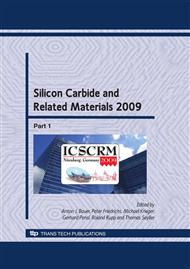p.725
p.729
p.733
p.737
p.741
p.745
p.749
p.753
p.759
SiC-Die-Attachment for High Temperature Applications
Abstract:
In this paper a die-attachment technology for high temperature applications based on the Low Temperature Joining Technique (LTJT) is presented. The present challenge is to fit the thermal expansion as well as the mechanical properties of the die-attach layer to the characteristics of chip and substrate. While the classic LTJT is based on sintering a sub-micron silver paste at temperatures between 150°C and 300°C to bond an electronic device to a substrate, the modified procedure employs a powder mixture consisting of silver powder and special filling powder material. Type and amount of the filling material is dependent on the application and the used substrates. Considering a low thermal expansion and high electrical as well as thermal conductivity we chose SiC, TiC, and BN as filling materials in this work.
Info:
Periodical:
Pages:
741-744
Citation:
Online since:
April 2010
Authors:
Keywords:
Price:
Сopyright:
© 2010 Trans Tech Publications Ltd. All Rights Reserved
Share:
Citation:


